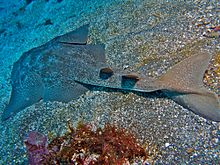日本扁鯊
| 日本扁鯊 | |
|---|---|

| |
| 科學分類 | |
| 界: | 動物界 Animalia |
| 門: | 脊索動物門 Chordata |
| 綱: | 軟骨魚綱 Chondrichthyes |
| 亞類: | 鯊總目 Selachimorpha |
| 目: | 扁鯊目 Squatiniformes |
| 科: | 扁鯊科 Squatinidae |
| 屬: | 扁鯊屬 Squatina |
| 種: | 日本扁鯊 S. japonica
|
| 二名法 | |
| Squatina japonica | |

| |
日本扁鯊(學名:Squatina japonica)為扁鯊科扁鯊屬的魚類,分佈於朝鮮半島西南部、日本本州中部以南以及黃海和東海沿海等。[2]該物種為底棲鯊魚,常生活於沙質海床上,最深可達300米。同其他扁鯊科物種一樣,日本扁鯊身體扁平,腹鰭與胸鰭為翅膀狀,背部中線附近有一排長棘。該魚背部有棕色與白色相間的雜亂圖案以及暗色的矩形斑紋。
日本扁鯊為夜行性伏擊捕食者,一天大部分時間均在海床上靜止不動。該物種為卵胎生,即受精卵在母鯊體內依靠卵黃發育完全後再誕生,其一胎所誕生的幼鯊數量在2-10條之間。日本扁鯊除非被打擾否則不會主動攻擊人類。該魚目前作為食用魚和鯊魚皮的來源被大量捕撈,現已被IUCN評為極危(CR)物種。[3]
物種分類[編輯]
荷蘭魚類學家彼得·布萊克爾於1858年在學術期刊《印度-荷蘭科學會雜誌》(Acta Societatis Scientiarum Indo-Neerlandicae)上首次描述日本扁鯊,其正模標本為一條53厘米長的雄性個體,捕獲於日本長崎。其種加詞japonica亦表明了其模式產地。[4][5]
在2010年,有學者通過線粒體DNA對17種扁鯊進行了種系發生學分析,結果顯示日本扁鯊同三種同樣分佈於亞洲的扁鯊台灣扁鯊、擬背斑扁鯊和印度尼西亞扁鯊Squatina legnota同屬一個演化支,並同分佈於歐洲和北非的扁鯊物種有所關聯。學者通過分子鐘推算出其大約在數千萬年前的白堊紀時期同其他亞洲扁鯊分離而獨立成種。[6]
外貌描述[編輯]

日本扁鯊身體相對較窄,胸鰭和腹鰭非常大,上半身覆蓋有中等大小的鱗片,頭部周圍的皮膚有褶皺但無明顯的葉片。魚眼寬大,為橢圓形,其後有位於其前側邊緣的新月形噴水孔。其鼻孔很大,前方各有一片帶有兩個倒鈎的魚皮,其中前側的倒鈎較細,而後側的倒鈎尖端為勺形,根部邊緣有一小片光滑的穗狀結構。日本扁鯊的嘴很寬,且其吻部四角附近的皮膚均有褶皺。其上下顎左右兩側均有10組牙齒,當中有縫隙將兩側的牙齒分開,這些牙齒小、窄而尖。日本扁鯊頭部有五對鰓裂。[5][7]
日本扁鯊胸鰭邊緣凸出,外側邊緣有稜角,內側邊緣則為圓形,前部有與頭部不相連的三角形葉片。背鰭有稜角,位於胸鰭的內側邊緣之後。尾柄扁平,兩側有龍骨突,尾部下半部大於上半部。該魚從背部中段至尾部有一排明顯的棘刺。該魚背部有棕色與白色相間的雜亂圖案以及暗色的矩形斑紋,下半身則為白色,間雜有斑駁的黑色。[5][7]
分佈[編輯]
日本扁鯊分佈於本州島以南的日本沿海、黃海、東海和台灣海峽[7] 。1984年出版的魚類圖鑑顯示在菲律賓出現過日本扁鯊[5],但有學者認為被目擊的扁鯊實際上系菲律賓扁鯊Squatina caillieti。[9]。
生態與習性[編輯]

日本扁鯊多生活於大陸架的沙質海床上,尤其是岩礁附近的海床。雖然該魚一般生活於淺水中,但有在352米深的深水中的出現記錄。[8][10]
日本扁鯊白天大部分時間均將自己埋於海床上的沙子中靜止不動,利用其斑駁複雜的體色來埋伏獵物。其獵物包括底棲魚類、頭足類和甲殼類。[11]
該魚已知的寄生蟲包括如下幾種:
- 絛蟲(Phyliobothrium marginatum和Tylocephalum squatinae[12])
- 橈腳類(Eudactylina squatini和Trebius shiinoi[13][14])
- 等足類(Gnathia trimaculata的若蟲[15])
同其他扁鯊一樣,日本扁鯊為卵胎生,即由卵黃為其發育中的胚胎提供養分直至出生。其生產季為春季至夏季,一胎可產下2-10隻幼鯊。新生的幼鯊平均長度為30厘米[16]。雌性在8-13歲時性成熟,此時體長約為80厘米,而雄性性成熟的數據則尚不清楚。日本扁鯊壽命可達35歲。[17]。
與人類的關係[編輯]
日本扁鯊一般對人類無害,但在受到威脅的情況下可對人類造成嚴重的咬傷。[5]
經濟利用[編輯]
日本扁鯊在日本某些地區是上等的料理食材[1]。雖然其魚鰭較小,但仍可作為魚翅食用。過小的個體一般會被碾碎作為魚食。[18]
種群現狀[編輯]
日本扁鯊目前面臨嚴重的過度捕撈威脅,韓國、日本、中國大陸和台灣的漁業均在1950年代起急速發展,漁船數量均成倍增加,日本扁鯊的種群因此急劇減少。雖然這些國家和地區均出台了若干對近海捕撈的限制,包括設置禁漁期、對漁網孔洞尺寸予以限制、禁止在沿岸水域使用摩托化的拖網等[19],但國內市場對魚肉和海產品的需求使得捕魚行為難以被遏制,加之屢禁不止的違法捕撈以及海洋污染和拖網作業對其棲息地的破壞,日本扁鯊仍然面臨極大的滅絕風險。[1]
參考文獻[編輯]
- ^ 1.0 1.1 1.2 1.3 Walls, R.H.L.; Rigby, C.L.; Derrick, D.; Dyldin, Y.V.; Ebert, D.A.; Herman, K.; Ishihara, H.; Jeong, C.-H.; Semba, Y.; Tanaka, S.; Volvenko, I.V.; Yamaguchi, A. Squatina japonica. The IUCN Red List of Threatened Species. 2021, 2021: e.T161558A134194013 [19 November 2021]. doi:10.2305/IUCN.UK.2021-1.RLTS.T161558A134194013.en
 .
.
- ^ 2.0 2.1 中國科學院動物研究所. 日本扁鲨. 《中國動物物種編目數據庫》. 中國科學院微生物研究所. [2009-04-11]. (原始內容存檔於2016-03-05).
- ^ Walls, R.H.L., Rigby, C.L., Derrick, D., Dyldin, Y.V., Ebert, D.A., Herman, K., Ishihara, H., Jeong, C.-H., Semba, Y., Tanaka, S., Volvenko, I.V. & Yamaguchi, A. Japanese Angelshark. The IUCN Red List of Threatened Species. 2019-08-29 [2022-09-20].
- ^ Bleeker, P. Vierde bijdrage tot de kennis der icthyologische fauna van Japan. Acta Societatis Scientiarum Indo-Neerlandicae. 1858, 3 (art. 10): 1–46.
- ^ 5.0 5.1 5.2 5.3 5.4 Compagno, L.J.V. Sharks of the World: An Annotated and Illustrated Catalogue of Shark Species Known to Date. Food and Agricultural Organization of the United Nations. 1984: 147–148. ISBN 978-92-5-101384-7.
- ^ Stelbrink, B.; von Rintelen, T.; Cliff, G.; Kriwet, J. Molecular systematics and global phylogeography of angel sharks (genus Squatina). Molecular Phylogenetics and Evolution. 2010, 54 (2): 395–404. PMID 19647086. doi:10.1016/j.ympev.2009.07.029.
- ^ 7.0 7.1 7.2 Walsh, J.H.; Ebert, D.A. A review of the systematics of western North Pacific angel sharks, genus Squatina, with redescriptions of Squatina formosa, S. japonica, and S. nebulosa (Chondrichthyes: Squatiniformes, Squatinidae). Zootaxa. 2007, 1551: 31–47.
- ^ 8.0 8.1 Michael, S.W. Reef Sharks & Rays of the World. Sea Challengers. 1993: 36. ISBN 978-0-930118-18-1.
- ^ Walsh, J.H.; D.A. Ebert & L.J.V. Compagno. Squatina caillieti sp. nov., a new species of angel shark (Chondrichthyes: Squatiniformes: Squatinidae) from the Philippine Islands. Zootaxa. 2011, 2759: 49–59.
- ^ Weigmann, S. 2016. Annotated checklist of the living sharks, batoids and chimaeras (Chondrichthyes) of the world, with a focus on biogeographical diversity. Journal of Fish Biology 88(3): 837-1037.
- ^ Ferrari, A.; Ferrari, A. Sharks
 . Firefly Books. 2002: 100. ISBN 978-1-55209-629-1.
. Firefly Books. 2002: 100. ISBN 978-1-55209-629-1.
- ^ Yamaguti, S. Studies on the Helminth fauna of Japan. Part 4. Cestodes of fishes. Japanese Journal of Zoology. 1934, 6: 1–112.
- ^ Izawa, K. Five new species of Eudactylina Van Beneden, 1853 (Copepoda, Siphonostomatoida, Eudactylinidae) parasitic on Japanese elasmobranchs. Crustaceana. 2011, 84 (12–13): 1605–1634. doi:10.1163/156854011x605792.
- ^ Nagasawa, K.; Tanaka, S.; Benz, G.W. Trebius shiinoi n. sp. (Trebiidae: Siphonostomatoida: Copepoda) from uteri and embryos of the Japanese angelshark (Squatina japonica) and the clouded angelshark (Squatina nebulosa), and redescription of Trebius longicaudatus. Journal of Parasitology. 1998, 84 (6): 1218–1230. PMID 9920318. doi:10.2307/3284678.
- ^ Ota, Y.; Hoshino, O.; Hirose, M.; Tanaka, K.; Hirose, E. Third-stage larva shifts host fish from teleost to elasmobranch in the temporary parasitic isopod, Gnathia trimaculata (Crustacea; Gnathiidae). Marine Biology. 2012, 159 (10): 2333–2347. doi:10.1007/s00227-012-2018-2.
- ^ Ebert, D.A., White, W.T., Ho, H.-C., Last, P.R., Nakaya, K., Séret, B., Straube, N., Naylor, G.J.P. and de Carvalho, M.R. 2013. An annotated checklist of the chondrichthyans of Taiwan. Zootaxa 3752(1): 279-386.
- ^ Cailliet, G.M., Mollet, H.F., Pittinger, G.G., Bedford, D. and Natanson, L.J. 1992. Growth and demography of the Pacific angel shark (Squatina californica), based upon tag returns off California. Australian Journal of Marine and Freshwater Research 43: 1313–1330.
- ^ Cardeñosa, D., Shea, K.H., Zhang, H., Feldheim, K., Fischer, G.A. and Chapman, D.D. 2020. Small fins, large trade: a snapshot of the species composition of low‐value shark fins in the Hong Kong markets. Animal Conservation 23: 203–211.
- ^ Yu, H. and Yu, Y. 2008. Fishing capacity management in China: Theoretic and practical perspectives. Marine Policy 32(3): 351–359.

